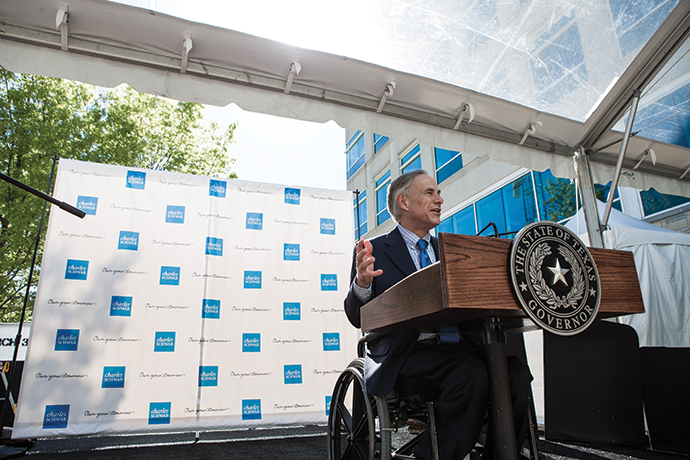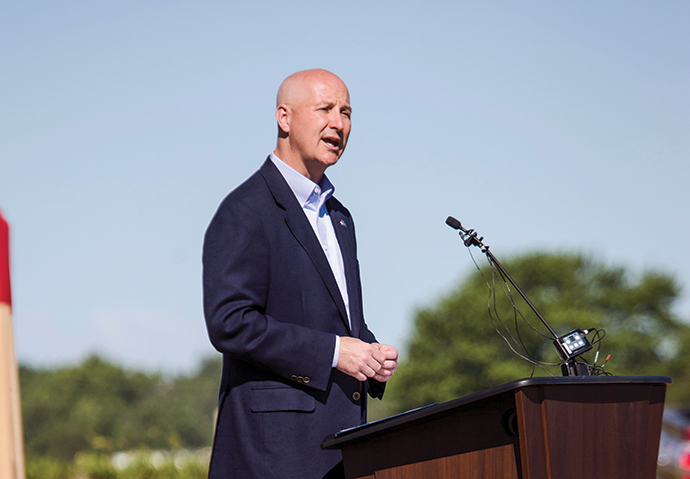What worked for Texas and Nebraska in 2016, and in previous years, worked just as well for them in 2017. Both states have successfully defended their claim to the Governor’s Cup they won last year — for total projects per capita in Nebraska’s case and for total qualified projects in Texas’. Both states’ investment attraction success in 2017 was impressive. Nebraska increased its project count from 101 to 110; Texas dropped from 642 in 2017 to 594 in 2017 but still finished well in front of runner-up Ohio’s 467.
This makes the fourth consecutive Governor’s Cup for Texas Governor Greg Abbott and the state’s sixth consecutive Cup. It’s the second Cup for per capita activity for Nebraska Gov. Pete Ricketts, and the state’s third.
Familiar faces round out the top five in each Governor’s Cup race: In total projects, following Ohio’s latest second place finish, Illinois is third with 419 projects, Georgia is fourth with 281 and North Carolina is fifth with 274. On the per capita side, this year’s results are not unlike last year’s. Ohio and Kentucky swapped places, with the Bluegrass State claiming second place with 248 projects followed by Ohio (467), Illinois (419) and Georgia.

Despite their vast difference in population, Texas with approximately 28 million residents and Nebraska with under 2 million have more than longitude on the globe in common. They are both leading locations for wind energy a factor behind recent investments in both states from Facebook. The social networking technology giant insists on its data centers being run by renewable energy — a capability not every state can deliver.
You’ll find an emerging Fintech industry in both states. Texas’ is further along but look closely and you’ll find players in the Omaha region, too. They know they don’t have to live in New York, Chicago or Silicon Valley to contribute to and capitalize on this sector. They also share strong business climates, plenty of room for ranches and thriving agriculture and food processing industries.
But ask Governors Abbott and Ricketts why they think their states won Site Selection’s facilities race again in 2017, and they both point first to their workforce.
Gov. Abbott frames his workforce remarks in an interview with Site Selection Editor Mark Arend in the context of Amazon’s HQ2 contest, a fight in which Texas has two contenders — Austin and the Dallas-Fort Worth metroplex.

“The business structure and friendliness attract businesses from across the country and the globe here,” says Gov. Abbott. “The geographic location matters, the regulatory environment matters, low taxes matter. But what matters most is what Amazon executives themselves say. A couple years ago I was at the grand opening of an Amazon facility in Shertz, Texas, just north of San Antonio. Executives there were in the process of opening several facilities in Texas. I asked them directly why they keep opening facilities in Texas, thinking they would tell me because taxes are lower, and your regulations are more reasonable and so forth. Instead, they were immediate and direct in their response: They said it’s the top-quality workforce.”
“One thing company leaders look for in their employees are people who are self-starters. Thousands of Texans demonstrated that. If we face a challenge, we will find ways to solve that challenge.”
Amazon operates seven fulfillment centers and three sortation centers in Texas.
“I’ve asked other CEOs who have broken ground on new headquarters and have moved to Texas from other states, why are they doing this? They all say the same thing, which is Texas has a top-notch workforce. So this is a great place for companies whether it be Amazon or Jamba Juice [headquartered in Frisco, Texas] that moved here over the past year. Or whether you’re a student at the University of Texas or the University of Georgia. Texas is a very inviting location, a place where anyone can come from anywhere and succeed. Dream big, and you can achieve your dreams. Texas has the entrepreneurial infrastructure that allows that type of success.”
Inundated and Resilient
The governor says Texans’ knack for overcoming obstacles big or small is another quality executives mention when discussing the state’s labor pool. That quality was stress-tested in spades when Hurricane Harvey roared onshore northeast of Corpus Christi in August 2017 as a category 4 storm. It would devastate Houston, Harris County and other locations with massive flooding and wind damage, causing an estimated $125 billion in damage.

“I have heard from businesses that are thinking about locating here or have located here over the past few months,” Gov. Abbott relates. “They say the attitude of Texans responding to the hurricane is one of the reasons they are so interested in our state. When you saw so many people in the flooded streets pull out their own boats and rescue people, it shows their can-do spirit, a spirit of not waiting around for others to provide solutions. One thing company leaders look for in their employees are people who are self-starters. Thousands of Texans demonstrated that. If we face a challenge, we will find ways to solve that challenge. We did that from the government level, but more importantly, we demonstrated it at the citizen level.”
Gov. Abbott says the rebuilding process has been “robust and prolific” and that different regions of Texas were affected in different ways.
“The hurricane winds blew down buildings and facilities in places like Rockport and Port Aransas — locations with a lot of businesses focused on tourism, fishing and so forth,” he explains. “It will take a while to rebuild there. People are very familiar with the flooding observed in Houston and Beaumont and Port Arthur. We’re moving aggressively to rebuild those regions. But here’s the important point: Working closely with Congress, we are ensuring that we’re doing more than rebuilding. We are rebuilding in a way that will reduce the potential flooding in the future. The reason for that is we are adding reservoirs, widening waterways and adding other mitigation to reduce flooding so that areas like Houston and Harris County will be more resilient in the future.”

Texas has received over $20 billion in recovery funding from Congress and was awaiting word at press time on another $20 billion that would be used for flood mitigation projects.
“Smart investors have realized this is an opportunity to go into places like Houston and invest,” says Abbott. “Whether it’s investors looking for homes to buy or businesses looking for buildings or real estate, this actually provides an opportunity to invest in areas. We’re seeing private-sector dollars beginning to flow in.
“I never want to say there is a silver lining to a hurricane,” the governor hastens to add. “But in the aftermath of a hurricane, there historically is a lot of investment that takes place because of the rebuilding effort. Because one affected area, Houston, is a large population center, which happens to be the energy capital of the world, and because the energy sector is producing more than in the past, the need to rebuild Houston bigger and better than before is more profound than ever before. Smart people are investing in Houston as we speak. We’re just focused on making sure the growth in Houston, Harris County and surrounding areas will be done in a smart approach to ensure it will reduce or prevent challenges like this from arising in the future. We can’t stop rain, but we can be a lot smarter about the way we retain water and redirect water flow to get it out to the Gulf of Mexico.”
By the Numbers
2017 Top States
by Number of Projects
| 2017 | 2016 | State | Projects |
| 1 | 1 | Texas | 594 |
| 2 | 2 | Ohio | 467 |
| 3 | 3 | Illinois | 419 |
| 4 | 5 | Georgia | 281 |
| 5 | 4 | North Carolina | 274 |
| 6 | 6 | California | 262 |
| 7 | 7 | Kentucky | 248 |
| 8 | 9 | Pennsylvania | 185 |
| 9 | 8 | Virginia | 164 |
| 10 | 17 | Indiana | 162 |
Economic development programs, such as the Texas Enterprise Fund — the state’s deal closing fund —are fully funded for the foreseeable future, but the governor cannot report progress on financial measures he has been championing for some time.
“In my first legislative session we cut the business margins franchise tax by 25 percent, and we cut property taxes by over $1 billion dollars,” he relates. “We had a bold property tax reduction proposal during the recent legislative session that did not pass. But the highest demand by our constituents for tax reform in Texas right now is property tax reform. Interestingly, it’s a plan that 15 other states have already adopted in a similar form, which is a 2.5-percent property tax revenue growth cap to limit the growth of property taxes so that people can stay in their homes and contain the cost of living.
“We were unable to reduce the business franchise tax further,” he says, “but it’s still part of our plan to continue chipping away at the margins tax until it is eliminated.
“The budget we passed this past year included my request for $100 million for economic development, which is what we’ve had since I’ve been governor,” he continues. “There is a corollary to that which is the Governor’s University Research Initiative, where we attract the best and brightest researchers from premier universities across the country — people who have won a Nobel Laureate or are on a pathway to achieving that, which means at a minimum they are required to be a member of a national honorific society, such as the National Academy of Sciences, the National Academy of Engineering, or National Academy of Medicine.”

Gov. Abbott says the program is attracting to Texas some of the premier researchers in the country.
“When they come to our universities they are bringing more than themselves,” he points out. “They often bring patents, research teams, there’s the establishment of labs and the involvement of students who will be working with them. This elevates our universities while at the same time stimulating our economy and providing high-paying jobs, while training the next generation of Texans to be thought leaders in fields that matter most to employers and to technological advancement.”
Oil, Gas & Fintech
Texas added nearly 307,000 new jobs in 2017, even with Harvey bringing business to a standstill in parts of the state for days and weeks on end. But that’s not the only highlight of the past year, says Gov. Abbott. “Even in a year with one of the biggest disaster challenges, Texas was a hotbed for new job growth. Unemployment lowered to the lowest on record and didn’t slow us down from remaining the top exporting state in the nation. The energy sector is expanding dramatically given the magnitude of what’s going on in the Permian Basin and surrounding areas. That’s leading to more oil and gas exploration and production but also a gigantic increase in shipment outside Texas.
2017 Top States
by Projects per capita
| 2017 | 2016 | State | Projects |
| 1 | 1 | Nebraska | 110 |
| 2 | 2 | Kentucky | 248 |
| 3 | 3 | Ohio | 467 |
| 4 | 5 | Illinois | 419 |
| 5 | 9 | Georgia | 281 |
| 6 | 6 | Iowa | 86 |
| 7 | 7 | North Carolina | 274 |
| 8 | 4 | Louisiana | 115 |
| 9 | 13 | South Carolina | 119 |
| 10 | 17 | Indiana | 162 |
“This past year, we shipped our first exporting ship of oil to India, for example,” notes Abbott. “We’re shipping oil and natural gas to countries across the globe that can increase our exports going forward. The place where we’re seeing a lot of advancement and increases is in two sectors. One is technology, which is very broad, be it the second largest Apple campus or the new, 27-acre Oracle campus or the technology industry in the Dallas and Houston area. Technology is expanding very rapidly in Texas. Also, Texas is becoming home to maybe more people working in the financial sector than any other state — we’re getting close to that.”
The overlap of finance and technology — Fintech — is catching on in Texas as in many other locations. “We are seeing that growth and expecting it here, too,” says the governor. “It shows the generational paradigm shift. Formerly, finance was headquartered in New York and if you worked in that industry you were required to be there. With the evolution of technology devices, you can relocate almost anywhere. Because we have the workforce Fintech is looking for and the space for it and the lower cost for it, a better regulatory environment, why be chained to New York City when you can go somewhere with lower taxes and lower costs of doing business? The math is very easy to see a pathway to making even more money at a lower cost of doing business.”
What does the governor have in store for 2018?
“We wake up every day searching for ways to make Texas a better place for people to live in and a better place for businesses to create jobs,” he says. “Often it comes back to the tried and true measurements of low taxes, reasonable regulations and right-to-work laws. Sometimes it means some different things. We will constantly search to find what employers need to make sure that Texas remains the very best place for business.”

Governor Pete Ricketts is a huge believer in his state’s workforce, part of which comes from his background as a major Nebraska employer — he was chief operating officer of TD Ameritrade.
“The main reason people want to invest in Nebraska is the people,” the governor tells Site Selection. “We consistently have one of the highest workforce participation rates. From personal experience, when you hire a Nebraskan you know he or she is well-educated and has a great work ethic. They are customer-focused and loyal — they really want to work. Take the Walmart distribution center here, for example. They say it is one of their most productive. Kawasaki loves the fact that Nebraskans are handy — they can fix things in a factory, and when they get a job there they stay for 30 years. That’s typical of Nebraskans.”
Also typical, says Ricketts, is the state’s team approach to landing new businesses. “Take Costco. When they came to visit Nebraska, the Fremont and Omaha chambers turned out over 100 business people to welcome them. I was impressed, and they really impressed the people from Costco. It was great team effort between the chambers, the local governments, the Departments of Agriculture, Economic Development, Transportation, Labor and Environmental Quality. They worked together as a team to be able to address the concerns Costco had with respect to what they would need. It was a team effort that helped bring Costco here.”
“I bring a business approach to how we’re managing state government – it’s about making government more effective and efficient and more customer-focused.”
Ground broke on Costco’s poultry processing plant in Fremont in June 2017. Projected to open in April 2019, the $300-million project is expected to generate an overall economic impact of $1.2 billion annually, create approximately 800 new jobs, and connect Costco to a dedicated network of producers in eastern Nebraska.
“At the end of the day, no company moves to a generic place called Nebraska,” the governor asserts. “They move to a specific community. If you get community support like we did in Fremont to be able to draw in Costco, that makes all the difference in the world. That really requires a team effort.”
On the Budget Front
Budget challenges were among the governor’s priorities for 2017, following news of his first — and Nebraska’s second — Governor’s Cup for projects per capita. He explains: “We had to close about a $900-million gap between what our expected forecasts were and the actual revenues that were coming in. We worked with the legislature to accomplish that without raising taxes. We’re living within our means. Frankly, we’re doing the same thing again this year. Our forecasts continue to lag, so we have another $200 million we have to address. If the legislature adopts my proposals for doing that, we will be growing our budget at 0.2 percent — essentially flat. By contrast, before I became governor, the budget was growing at 6.5 percent per year. We have done what every household has to do when they see their income go down. They tighten their belts, make the tough decisions and live within their means. And we’re not raising taxes.”

Can Nebraska deliver the fiscal soundness and predictability that capital investors look for?
“I bring a business approach to how we’re managing state government — it’s about making government more effective and efficient and more customer-focused,” says the governor. “Part of that is financial management and making sure we’re living within our means and not saying we’ll raise taxes to be able to fill this hole. At the same time,” he adds, “it’s important to note that we’re delivering better service.”
People equate cutting budgets to cutting services, Gov. Ricketts says, but it’s not always true.
“Just as in the private sector, you can actually do a better job delivering services while you’re controlling your costs at the same time.”
Another of the governor’s priorities for 2017 was making state government more efficient, and construction permits now are available in a day or two, down from weeks or months in the past, he illustrates. “There is a wide variety of areas we can demonstrate we are doing a better job serving people.”
Will Tax Relief Happen in 2018?
Another issue the governor is working on is the valuation of agricultural land, of which there is no shortage in Nebraska.
“We had a proposal to change the way we value ag land last year,” says Ricketts. “We have a filibuster rule, so bills can be filibustered, and our tax bill got filibustered last year. So I worked with the chair of the revenue committee across the summer and fall and talked to a variety of different groups discussing what new bill we would bring back. We have proposed a new tax relief bill this year that will start off at a 12 percent credit based on all property taxes you pay, and this will benefit ag producers tremendously. We want to increase that from 12 percent to 30 percent by 2031. So we are scheduling the tax relief over a period of years so we can manage it within our budget. That will help our ag producers manage their property taxes over that 14 years or so.”

The governor recalls a recent hearing where a farmer had done the math and testified that if the legislature were to pass this bill he would be able to provide stability to his property taxes over the course of the next 14 years.
“We also have a piece on reducing our income tax rates, lining up our corporate tax rate and our individual tax rate and bringing them down from their current levels — corporate is 7.81 percent and individual is 6.84 percent — and working in two steps to bring them down to 6.69 percent. It’s not the most dramatic change, but progress is being made, and we’re managing it within our budget.
“The third part of our tax bill has to do with workforce development and making additional investments there to make sure we have the right trained, skilled workforce here in our state,” says Ricketts.
“Something we continue to make commitments to, even with our budget constraints, is our Developing New Talent initiative, which is a grant program that encourages private-sector companies to work with school districts to create programs centered around science, technology, automotive, construction — those types of skilled trades to get young people interested in that. Then they pick that up again in high school and follow through with a two-year post-secondary education if that’s what they need. Hastings, which has been with us since the first year, has seen a 15 percent increase in the number of kids taking those classes once they get to high school. This creates a pipeline in our state for that skilled labor force. Even if companies don’t get the grants, we’ve found that they continue to work with the school districts. We have to have a bill that makes us competitive in both agriculture and our urban business interests and fosters the right workforce here in Nebraska to continue to expand. This is a pro-growth tax bill.”
Foreign Investment Picks Up
Nebraska has strong ties to foreign markets, which Governor Ricketts intends to build on. This is particularly important, he says, as the specter of NAFTA renegotiations looms.
“I was in Canada on a trade mission last year — the first Nebraska governor to go there on a trade mission,” he states. “Basically, that was to thank our biggest customer and to highlight how beneficial NAFTA has been not only for the United States, Canada and Mexico, but for Nebraska in particular. As an ag state, we produce way more food than we can consume and we need to be able to tap into overseas markets to sell our products.”
While in Canada, the governor prevailed on a plastics company there to consider Nebraska as it mulled a US expansion. In October, Ontario-based Agri-Plastics announced plans to invest in Sidney with a facility that will enhance production efforts at Agri-Plastics’ two full-capacity plants in Canada. Established in 1995, the company manufactures calf hutches and plastic products to support North America’s dairy industry. Agri-Plastics plans to hire more than 20 employees in the Sidney location for manufacturing and production jobs.

Kawasaki’s first aerospace operation in the US is in Lincoln, notes the governor, where cargo doors are being built for Boeing’s 777X cargo aircraft. Railcars are also built at the facility. And Nebraska beef is now being exported to China for the first time in more than a dozen years.
“We will continue to go back to places like Japan and China to expand those marketplaces,” says Ricketts. “We’re excited that Japan is set to open its market to US ethanol; Argentina opened its market to pork last year, and Vietnam has opened its market to distillers’ grains. And Nebraska has signed a memorandum of understanding with Bulgaria to sell soybeans. We are aggressively pursuing international trade to open those opportunities to Nebraska businesses.”
As for NAFTA renegotiation, says Ricketts, “there are a lot of opportunities to improve the agreement — a lot has changed in the world in 25 years. There is a big opportunity in dairy, for example. But it’s also important that we not disrupt the trade relationship. It’s been very beneficial for all three countries involved, and in particular, Nebraska.”
On the technology side of the state’s industrial base, Nebraska is welcoming a major Facebook project in Sarpy County, near Omaha.
“That represents an investment of hundreds of millions of dollars and hundreds of jobs created, and it speaks to our data center cluster,” says Gov. Ricketts. “They’re joining companies like Travelers and Yahoo!. Part of what sold Facebook was Omaha Public Power District being able to guarantee them 100 percent renewable energy at a price they were willing to pay. This gets back to the team effort. OPPD was able to help close the deal.”
Can Nebraska differentiate itself from neighboring states — or those farther afield — and secure a third consecutive Governor’s Cup? That’s the plan, says Ricketts.
“We have the best people in the world, first,” he relates. “I can relate directly to businesses coming in and wondering about that, because at TD Ameritrade, we hired thousands of Nebraskans. Second, we’re running the state more like a business — more effectively and efficiently, which helps us to control our costs and not have to raise taxes. Third is cutting red tape. We are continuing to drive a state that is customer-friendly by getting rid of the regulations that are antiquated and making the state easier to do business with.”

